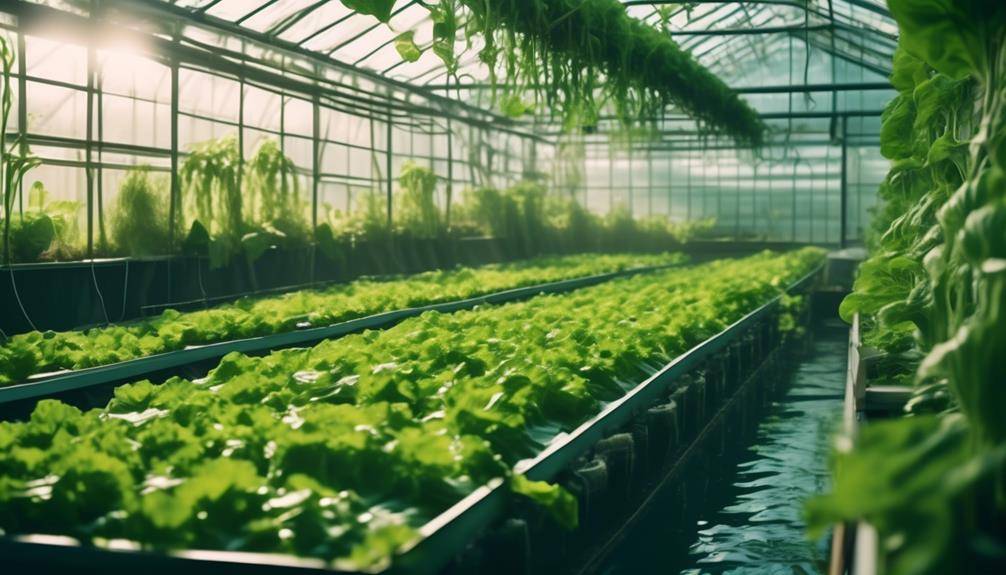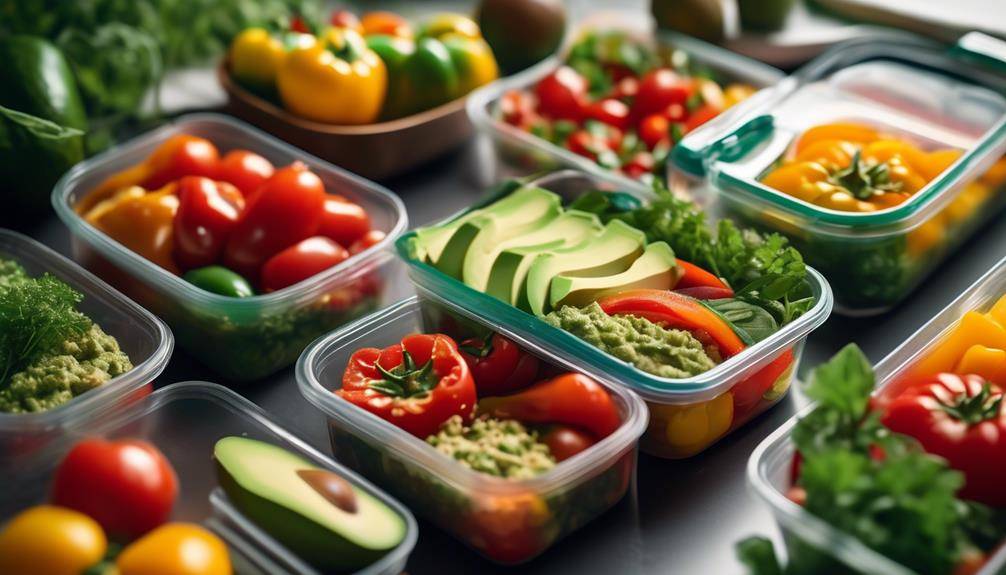Emerging Role Of Aquaponics In Modern Farming

Role Of Aquaponics In Modern Farming; Imagine a future where farming is not limited by traditional methods and the constraints of land and water resources. Instead, it embraces a revolutionary approach that combines aquaculture and hydroponics, creating a harmonious ecosystem that benefits both plants and fish. This is the world of aquaponics, a cutting-edge technique that has gained traction in modern agriculture. But what exactly is aquaponics, and why is it considered a game-changer in the realm of food production? The answer lies in its ability to revolutionize resource utilization, promote sustainability, and address pressing challenges in our food system.
Efficient Use of Resources
Efficiently utilizing resources is a key aspect of modern aquaponics farming, allowing for maximum productivity and sustainability. Resource optimization is at the heart of aquaponics, which is a system that combines aquaculture and hydroponics to create a symbiotic relationship between fish and plants. This method minimizes waste and maximizes the use of available resources.
One of the main benefits of aquaponics is its low environmental impact. Traditional farming practices often lead to soil degradation, water pollution, and excessive use of fertilizers and pesticides. In contrast, aquaponics reduces these negative effects by recycling and reusing resources. The fish waste produced in the aquaculture component of the system is converted into nutrients for the plants in the hydroponics component. This eliminates the need for synthetic fertilizers and reduces the risk of water pollution.
Furthermore, aquaponics is highly efficient in terms of water usage. Traditional farming methods require large amounts of water, leading to excessive consumption and waste. Aquaponics, on the other hand, utilizes a recirculating system where water is continuously cycled through the fish tanks and plant beds. This significantly reduces water consumption, making aquaponics a more sustainable farming method.
In addition to water conservation, aquaponics also optimizes the use of space. The integration of fish and plants in a single system allows for vertical farming, maximizing the use of available land. This is particularly beneficial in urban areas where space is limited.
Sustainable Food Production
Aquaponics’ resource optimization extends to sustainable food production, ensuring maximum productivity and environmental benefits. One way aquaponics achieves this is through vertical farming. By utilizing vertical space, aquaponic systems can produce a higher yield of crops compared to traditional farming methods that only use horizontal space. Vertical farming allows for multiple layers of plants to be grown, maximizing the use of available space. This not only increases the production capacity but also reduces the need for land, making it a more sustainable approach to food production.
Another aspect of sustainable food production in aquaponics is community engagement. Aquaponic systems can be set up in urban areas, bringing food production closer to the consumers. This not only reduces transportation costs and carbon emissions associated with long-distance food transportation but also creates opportunities for the local community to actively participate in food production. Community members can learn about aquaponics, get involved in maintaining the system, and even grow their own food. This fosters a sense of ownership and connection to the food they consume, promoting a more sustainable and resilient food system.
Furthermore, the use of aquaponics significantly reduces water consumption compared to traditional farming methods. The closed-loop system in aquaponics recirculates and filters water, minimizing water waste. This is particularly important in regions facing water scarcity or drought conditions. By conserving water, aquaponics contributes to sustainable food production while addressing the global water crisis.
Water Conservation and Management
To effectively manage and conserve water in aquaponics, it is essential to implement efficient irrigation techniques. One of the key strategies for water conservation in aquaponics is water recycling. In this system, water is continuously circulated between the fish tanks and the plant beds, allowing the plants to take up the necessary nutrients from the fish waste, while the fish benefit from the purified water returned to their tanks. This closed-loop system significantly reduces water consumption compared to traditional farming methods.
Another approach to water conservation in aquaponics is the integration of hydroponics. Hydroponics is a soilless method of growing plants, where the roots are submerged in nutrient-rich water. By combining aquaponics with hydroponics, water usage can be further minimized. The water from the aquaponics system can be used to nourish the hydroponic plants, and then the excess water can be recycled back into the aquaponics system.
In addition to water recycling, efficient irrigation techniques play a crucial role in water conservation. Drip irrigation is commonly used in aquaponics, as it delivers water directly to the plant roots, minimizing water loss through evaporation or runoff. By providing water only where it is needed, drip irrigation ensures that every drop is used efficiently.
To maximize water conservation in aquaponics, it is important to monitor and manage the water quality. Regular testing of the water parameters, such as pH, ammonia, and nitrate levels, can help maintain optimal conditions for both fish and plants. By maintaining proper water quality, the need for water changes can be minimized, further reducing water consumption.
Elimination of Synthetic Fertilizers
You’ll be pleased to know that aquaponics offers a chemical-free nutrient supply for plants. By utilizing the waste produced by fish in the system, the plants receive a natural and balanced nutrient supply, eliminating the need for synthetic fertilizers. This sustainable agricultural practice not only promotes healthier and more nutritious crops, but also helps to protect the environment by reducing the use of harmful chemicals in farming.
Chemical-Free Nutrient Supply
By eliminating the need for synthetic fertilizers, aquaponics provides a chemical-free nutrient supply for modern farming. This method of farming combines aquaculture and hydroponics, creating a symbiotic relationship between fish and plants. Here’s how aquaponics ensures a chemical-free nutrient supply:
- Fish waste: In aquaponics, fish waste serves as a natural source of nutrients for the plants. The fish excrete ammonia, which is then converted into nitrates by beneficial bacteria. These nitrates are absorbed by the plants, providing them with essential nutrients.
- Beneficial bacteria: The presence of beneficial bacteria in aquaponics systems helps convert harmful ammonia into nitrites and then into nitrates. These nitrates act as a natural fertilizer for the plants.
- Natural filtration: Aquaponics systems utilize natural filtration techniques, such as mechanical and biofiltration, to maintain water quality. This ensures that the plants receive clean, nutrient-rich water without the need for chemical fertilizers.
Sustainable Agricultural Practices
Sustainable agricultural practices revolutionize modern farming by eliminating the reliance on synthetic fertilizers. With the increasing awareness of environmental issues and the desire for healthier food options, sustainable farming techniques and organic farming methods have gained significant popularity. These methods prioritize the use of natural and renewable resources, minimizing the negative impact on the environment while promoting soil health and fertility.
One of the key aspects of sustainable farming is the elimination of synthetic fertilizers. Instead, farmers rely on organic fertilizers such as compost, manure, and cover crops. These natural alternatives provide essential nutrients to the soil, promoting healthy plant growth and improving soil structure. By avoiding synthetic fertilizers, farmers not only reduce the risk of chemical runoff into water bodies but also maintain long-term soil health.
Furthermore, sustainable agricultural practices focus on crop rotation and intercropping. These techniques help to naturally control pests and diseases, reducing the need for chemical pesticides. Additionally, they promote biodiversity and increase soil fertility by improving nutrient cycling.
Maximizing Space Utilization
To effectively maximize space utilization in aquaponics farming, it is crucial to carefully plan and organize the layout of the system. By implementing vertical farming techniques and utilizing hydroponic systems, you can make the most out of limited space and increase your overall productivity. Here are three key strategies for maximizing space utilization in aquaponics farming:
- Vertical Farming: Vertical farming involves growing plants in stacked layers, allowing you to make use of vertical space. By utilizing vertical racks or shelves, you can grow a larger number of plants in a smaller footprint. This method is especially useful in areas where land is scarce, making it an ideal choice for urban farming. With vertical farming, you can grow a variety of crops such as leafy greens, herbs, and even small fruiting plants, all within a compact space.
- Hydroponic Systems: Hydroponics is a soilless growing technique that uses water and nutrient solutions to cultivate plants. This method eliminates the need for traditional soil-based farming, allowing for greater space efficiency. Hydroponic systems can be designed in various configurations, such as nutrient film technique (NFT) or deep water culture (DWC), depending on the crops you wish to grow and the available space. These systems allow for precise control over nutrient delivery, water usage, and plant spacing, maximizing the use of space while optimizing plant growth.
- Companion Planting: Companion planting involves growing different crops together that benefit each other’s growth. By choosing compatible plant combinations, you can optimize space utilization and maximize productivity. For example, tall plants can provide shade to smaller plants, while certain plants can repel pests that may harm neighboring crops. Companion planting not only saves space but also promotes biodiversity and enhances overall system resilience.
Incorporating these strategies into your aquaponics farming system will enable you to effectively maximize space utilization and achieve higher yields. With careful planning and implementation, you can make the most out of limited space while producing a diverse range of crops efficiently.
Addressing Food Security Challenges
What are the key strategies for addressing food security challenges in aquaponics farming? One of the main strategies is the incorporation of vertical farming techniques. Vertical farming allows for the efficient use of limited space by stacking plants vertically, maximizing the production capacity of aquaponics systems. By utilizing vertical space, farmers can grow more crops in a smaller footprint, increasing the overall productivity of the farm and addressing food security challenges.
Another important strategy is community engagement. Aquaponics farming can play a crucial role in enhancing food security at the community level. By actively engaging with the local community, farmers can promote the benefits of aquaponics and encourage community participation in the farming process. This can include educational programs, workshops, and public demonstrations to raise awareness about the importance of sustainable farming practices and the potential of aquaponics in addressing food security challenges.
Furthermore, community engagement can extend to the establishment of community-based aquaponics systems. These systems can be set up in schools, community centers, or other public spaces, allowing community members to actively participate in the production of fresh and nutritious food. This not only addresses food security challenges but also promotes community empowerment, education, and self-sufficiency.
Enhancing Urban Farming Opportunities
Urban farming offers a unique solution to the challenges of limited space and increasing demand for sustainable food production. With urban areas becoming more densely populated, traditional agriculture methods are often impractical. However, by utilizing innovative techniques like aquaponics, urban farmers can maximize productivity in limited spaces while minimizing resource consumption. This allows for the cultivation of fresh, nutritious produce right in the heart of cities, contributing to food security and promoting a more sustainable future.
Urban Space Limitations
One can overcome the challenges of limited urban space by implementing innovative techniques such as aquaponics, enhancing the opportunities for urban farming. With the rise of urban farming challenges and the increasing need for sustainable food production, aquaponics provides a promising solution. Here’s how aquaponics can address urban space limitations:
- Vertical farming technologies: Aquaponics utilizes vertical farming methods, allowing farmers to grow plants in stacked layers. This maximizes the use of limited space by utilizing the vertical dimension, making it possible to grow more crops in a smaller area.
- Compact systems: Aquaponics systems are designed to be compact and efficient. They can be set up in small spaces such as balconies, rooftops, or even indoors. This enables urban farmers to utilize unused spaces and convert them into productive farms.
- Multi-functional spaces: Aquaponics systems can be integrated into existing urban infrastructure, such as buildings or parking lots. By utilizing unused spaces, these systems can transform underutilized areas into productive urban farms, providing fresh produce to local communities.
Sustainable Food Production
To enhance urban farming opportunities and promote sustainable food production, aquaponics offers an innovative solution that integrates fish farming and plant cultivation in a symbiotic system. Aquaponics not only maximizes the use of limited urban space but also addresses the challenge of food waste reduction and economic viability.
In aquaponics, fish waste serves as a natural fertilizer for plants, while the plants filter and purify the water for the fish. This closed-loop system eliminates the need for chemical fertilizers and reduces water consumption by up to 90% compared to traditional farming methods. By utilizing vertical growing methods, aquaponics allows for higher crop yields and increased productivity in urban areas.
Furthermore, aquaponics presents economic opportunities for urban farmers. The integration of fish and plant production creates multiple revenue streams, including the sale of both fresh produce and fish. Additionally, the reduced water and energy requirements result in cost savings for farmers, making aquaponics economically viable and sustainable in urban environments.
Promoting Biodiversity and Ecosystem Health
Promoting biodiversity and ecosystem health is crucial in modern farming as it enhances the overall resilience and sustainability of the aquaponics system. By incorporating biodiversity conservation and promoting ecosystem resilience, aquaponics can create a balanced and thriving environment for both plants and fish. Here are three ways in which aquaponics promotes biodiversity and ecosystem health:
- Diverse plant species: In an aquaponics system, various types of plants can be grown together, creating a diverse and rich ecosystem. This diversity not only enhances the aesthetic appeal of the system but also provides a range of benefits. Different plants have different nutritional needs, so growing a variety of plant species ensures that all nutrients are efficiently utilized. Additionally, diverse plants attract a variety of beneficial insects and pollinators, further promoting biodiversity.
- Beneficial bacteria and microorganisms: Aquaponics relies on beneficial bacteria and microorganisms to convert fish waste into nutrients for the plants. These bacteria play a vital role in maintaining the health of the system. By promoting the growth of beneficial bacteria, aquaponics systems create a balanced ecosystem where waste is efficiently processed, preventing the buildup of harmful toxins.
- Conservation of water and energy: Aquaponics systems are designed to be highly efficient in water and energy use. Unlike traditional farming methods, aquaponics recirculates water, minimizing wastage. This conservation of water not only reduces the strain on local water resources but also helps maintain the stability of the ecosystem. Additionally, aquaponics systems require less energy compared to conventional farming methods, further contributing to the overall sustainability of the system.
Potential for Scalability and Commercialization
Aquaponics systems offer significant potential for scalability and commercialization, making them a viable option for entrepreneurs looking to enter the modern farming industry. While traditional farming methods face challenges of land scarcity and limited resources, aquaponics offers a solution by maximizing space and resources through its integrated system of aquaculture and hydroponics. This innovative approach allows for the cultivation of both fish and plants in a symbiotic relationship, creating a sustainable and efficient farming method.
One of the key advantages of aquaponics is its scalability. The system can be easily expanded or downsized to meet the needs of the farmer. This flexibility allows for the optimization of production based on market demand, making aquaponics an attractive option for commercial farming. Additionally, aquaponics can be implemented in various settings, including urban areas where space is limited. By utilizing vertical farming techniques and utilizing unused spaces such as rooftops or warehouses, aquaponics can be scaled up to maximize production without the need for large land areas.
However, scalability does come with its challenges. As the system grows in size, maintaining the delicate balance between fish and plant production becomes more complex. Careful monitoring of water quality, nutrient levels, and oxygen levels is essential to ensure the health and productivity of the system. Additionally, managing the logistics of larger-scale aquaponics operations can be demanding, requiring skilled labor and efficient automation systems.
Despite these challenges, aquaponics has shown economic viability in commercial farming. By eliminating the need for chemical fertilizers and reducing water consumption, aquaponics can significantly lower production costs. Furthermore, the ability to cultivate high-value crops such as herbs or specialty fish species can lead to increased profitability. As consumer demand for sustainable and locally grown food continues to rise, aquaponics has the potential to carve out a significant market share in the modern farming industry.
Role Of Aquaponics In Modern Farming; Frequently Asked Questions
Can Aquaponics Be Used in Small-Scale Farming or Is It Only Suitable for Large-Scale Commercial Operations?
Aquaponics can definitely be used in small-scale farming. It is not just suitable for large-scale commercial operations. In fact, small scale aquaponics systems are perfect for home gardening and can provide fresh produce and fish year-round.
How Does Aquaponics Address the Issue of Water Pollution Caused by Traditional Farming Methods?
Aquaponics directly addresses the issue of water pollution caused by traditional farming methods. It conserves water by recycling and reusing it within the system, resulting in a more sustainable and environmentally-friendly approach to farming.
Are There Any Specific Crops That Thrive in Aquaponic Systems?
In aquaponic systems, specific crops like leafy greens, herbs, and certain fruits thrive due to the nutrient-rich water from fish waste. This advantage makes aquaponics ideal for urban areas with limited space and access to traditional farming methods.
How Does Aquaponics Contribute to Reducing Greenhouse Gas Emissions in Comparison to Traditional Farming?
Aquaponics reduces greenhouse gas emissions compared to traditional farming by utilizing a closed-loop system where the waste from fish is converted into nutrients for plants. This sustainable farming method helps to lower your carbon footprint.
What Are Some Potential Challenges or Limitations of Implementing Aquaponics in Urban Areas?
Some potential challenges and limitations of implementing aquaponics in urban areas include limited space, zoning regulations, and access to resources. However, with proper planning and innovative solutions, these challenges can be overcome to promote sustainable urban agriculture.
Conclusion
In conclusion, aquaponics plays a crucial role in modern farming by offering efficient resource use, sustainable food production, water conservation, and elimination of synthetic fertilizers. It maximizes space utilization, addresses food security challenges, and enhances urban farming opportunities. Additionally, it promotes biodiversity and ecosystem health, while also showing potential for scalability and commercialization. With its numerous benefits, aquaponics is a promising solution for meeting the growing demand for food in a resource-efficient and environmentally friendly manner.








